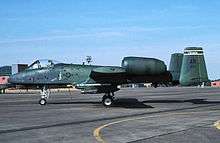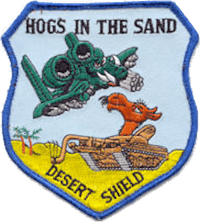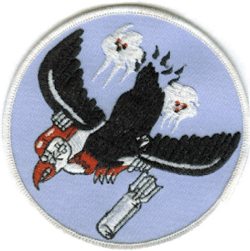511th Tactical Fighter Squadron
| 511th Tactical Fighter Squadron | |
|---|---|
|
Emblem of the 511th Tactical Fighter Squadron | |
| Active | 1943–1992 |
| Country | United States |
| Branch | United States Air Force |
| Type | Tactical Fighter |



The 511th Tactical Fighter Squadron is an inactive United States Air Force unit. It was last assigned to the 10th Tactical Fighter Wing, stationed at RAF Alconbury, England. It was inactivated on 30 December 1992.
History
World War II
Established as a dive-bomber squadron in early 1943, trained under Third Air Force with A-24 Banshees (the USAAF version of the Navy Douglas SBD Dauntless). Converted to a P-39 Airacobra squadron in August and finally into a P-47 Thunderbolt fighter squadron in late 1943.
Deployed to the European Theater of Operations (ETO), being assigned to IX Fighter Command in England in early 1944. Engaged in ground attacks of enemy fortifications; controlled bridges, railway lines, roads, armor and troop concentrations in Occupied France and the Low Countries; carrying out fighter sweeps of Luftwaffe-controlled airfields. Flew patrols over the Normandy Landing Beaches, 6 June 1944, later taking up station in newly constructed airfields in liberated areas of France. Engaged and completely destroyed a German armored division near Avranches, France, 29 July 1944. After immobilizing leading and trailing elements of the 3 mile (4.8 km) long column, the rest of the tanks and trucks were systematically destroyed with multiple sorties.
After the breakout at St Lo; squadron's mission was to provide air support in advance of the United States Third Army as it moved eastward across France, and as part of the Western Allied invasion of Germany in March 1945. Continued attacking ground targets until German Capitulation in May 1945. Gradually demobilized as part of the United States Air Forces in Europe occupation forces during the summer of 1945, inactivated in the United States as an administrative unit in October.
Pacific Air Forces
Reactivated in 1952 as a Tactical Air Command squadron under Ninth Air Force. Equipped with F-84 Thunderstreaks, later upgrading to F-100 Super Sabres in 1956. When its home station (Godman AFB, Kentucky) was closed due to budget reductions in 1959, was reassigned to Pacific Air Forces in the Philippines. Re-equipped with F-86D Sabre interceptors, and provided air defense for that island nation in the early 1960s. Re-equipped with modern F-102 Delta Dagger interceptors in late 1960. As the Vietnam War intensified, deployed flights to both Thailand and South Vietnam throughout the 1960s, providing air defense of Bangkok and Saigon as well as other areas from enemy aircraft. Inactivated in 1970 with the phaseout of the F-102 as well as the general drawdown of United States forces in Indochina.
United States Air Forces in Europe
Reactivated in 1980 as an A-10 Thunderbolt II Tactical Fighter Squadron at RAF Bentwaters, England under USAFE Third Air Force. Flew tactical fighter training missions throughout the 1980s from the United Kingdom as well as a forward location at Sembach Air Base, West Germany.
Reassigned to the 10th Tactical Fighter Wing at RAF Alconbury in 1988 in a USAFE dispersal of the 4-squadron host at Bentwaters. Subsequent forward operating locations included RAF Ahlhorn and Leipheim Air Base, Germany.
Deployed to Saudi Arabia, December 1990 as part of USAF buildup of forces after Iraq's invasion of Kuwait. Was one of the initially deployed USAF units as part of Operation Desert Shield, providing defense of Saudi Arabia. Engaged in combat operations, January–February 1991 effectively destroying large numbers of Iraqi tanks and other armor as part of Operation Desert Storm. One 511th pilot was responsible for an extremely rare air-to-air kill of a Mil Mi-8 "Hip" helicopter (one of only two air-to-air A-10 kills of the war). Aircraft contributed significantly to destruction of hundreds of enemy vehicles and many of their occupants on Highway 80, 26–27 February 1991, directly leading to President George H. W. Bush's decision to declare a cessation of hostilities on the next day.
Returned to England in June 1991, however squadron was almost immediately drawn down as part of previously planned inactivation as a result of the end of the Cold War and a general reduction of USAFE forces afterward. Inactivated at the end of 1992.
Lineage
- Constituted 626th Bombardment Squadron (Dive) on 4 Feb 1943
- Activated on 1 Mar 1943
- Re-designated: 511th Fighter-Bomber Squadron on lo Aug 1943
- Re-designated: 511th Fighter Squadron on 30 May 1944
- Inactivated on 15 Oct 1945
- Re-designated 511th Fighter-Bomber Squadron on 15 Oct 1952
- Activated on 1 Dec 1952
- Inactivated on Jul 1958
- Re-designated 511th Fighter-Interceptor Squadron on 11 Mar 1959
- Activated on 9 Apr 1959
- Personnel and equipment re-designated 353d Tactical Fighter Squadron on 24 July 1970, inactivated same date.
- Re designated 511th Tactical Fighter Squadron on 1 Jan 1980 and activated
- Inactivated on 30 Dec 1992
Assignments
- 405th Bombardment (later Fighter-Bomber; Fighter) Group, i Mar 1943-15 Oct 1945
- 405th Fighter-Bomber Group, 1 Dec 1952
- 405th Fighter-Bomber Wing, 8 Oct 1957 – 1 Jul 1958
- 405th Fighter Wing, 9 Apr 1959 – 24 July 1970
- 81st Tactical Fighter Wing, 1 Jan 1980
- 10th Tactical Fighter Wing, 1 Sep 1988 – 30 Dec 1992
- Squadron attached to 354th Tactical Fighter Wing (Provisional), 15 Aug 1990 – 25 Mar 1991
Stations
|
|
Aircraft
|
|
References
![]() This article incorporates public domain material from the Air Force Historical Research Agency website http://www.afhra.af.mil/.
This article incorporates public domain material from the Air Force Historical Research Agency website http://www.afhra.af.mil/.
- Maurer, Maurer, ed. (1982) [1969]. Combat Squadrons of the Air Force, World War II (PDF) (reprint ed.). Washington, DC: Office of Air Force History. ISBN 0-405-12194-6. LCCN 70605402. OCLC 72556.
